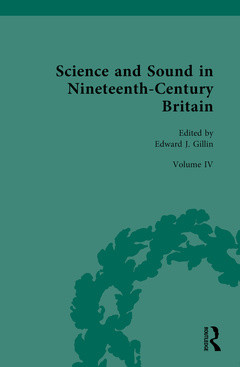Science and Sound in Nineteenth-Century Britain Sound Transformed Nineteenth-Century Science, Technology and Medicine: Sources and Documents Series
Langue : Anglais
Coordonnateur : Gillin Edward J.

Sound and Science in Nineteenth-Century Britain is a four-volume set of primary sources which seeks to define our historical understanding of the relationship between British scientific knowledge and sound between 1815 and 1900. In the context of rapid urbanization and industrialization, as well as a growing overseas empire, Britain was home to a rich scientific culture in which the ear was as valuable an organ as the eye for examining nature. Experiments on how sound behaved informed new understandings of how a diverse array of natural phenomena operated, notably those of heat, light, and electro-magnetism. In nineteenth-century Britain, sound was not just a phenomenon to be studied, but central to the practice of science itself and broader understandings over nature and the universe. This collection, accompanied by extensive editorial commentary, will be of great interest to students and scholars of the History of Science.
Volume 4
Acknowledgements
Chronology
Introduction
- John Tyndall, Sound: A Course of Eight Lectures Delivered at the Royal Institution of Great Britain, (Longmans, Green, and Co: London, 1867), pp. vii-ix and 255-325.
- George Biddell Airy, ‘On the Elements of Musical Harmony and Melody, and of Simple Musical Composition’, On Sound and Atmospheric Vibrations, with the Mathematical Elements of Music. Designed for the Use of Students of the University, (Macmillan and Co: London, 1868), pp. 197-231.
- Hermann Helmholtz, On the Sensations of Tone as a Physiological Basis for the Theory of Music, (Trans.), Alexander J. Ellis, (Longmans, Green, and Co: London, 1875), pp. v-xi, 11-37, 56-77.
- J. W. Strutt, The Theory of Sound, vol. 1 of 2 (Macmillan: London, 1877), pp. v-vi, 1-66.
- J. W. Strutt, The Theory of Sound, vol. 2 of 2 (Macmillan: London, 1877), pp. 85-134.
- (Anon.), "Recent Developments in Acoustical Science", 19th Aug., 1878, The Times, (London, England), Issue 29337, p. 4.
- Edmund Gurney, The Power of Sound, (Smith, Elder, & Co: London, 1880), pp. v-xi, 1-39, 113-126, 178-201, 524-539.
- Richard Wallaschek, Primitive Music: An Inquiry into the Origin and Development of Music, Songs, Instruments, Dances, and Pantomimes of Savage Races (London: Longmans, Green, and Co, 1893), pp. 237-289.
Bibliography
Index
Postgraduate and Undergraduate Advanced
Dr Edward J. Gillin is Lecturer in the History of Building Sciences and Technology at the Bartlett School of Sustainable Construction in University College London. A cultural historian of nineteenth-century Britain, he specialises in questions of science, technology, and architecture, and how these relate to broader histories of society, politics, and religion.
Date de parution : 12-2023
15.6x23.4 cm
Thèmes de Science and Sound in Nineteenth-Century Britain :
© 2024 LAVOISIER S.A.S.


